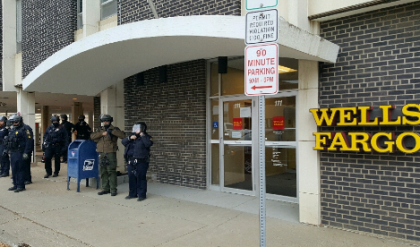Police Attack Unarmed Water Protectors w/ Rubber Bullets, Tear Gas, and Water Cannons; 300+ injured
UPDATE (6/12/17) – Emails released by The Intercept as part of their investigation into leaked documents from DAPL security contractor TigerSwan include an “Intel Group” email thread which took place in real time the night of November 20, 2016. The emails show local, state, and federal officials monitoring the presence of media at Backwater Bridge that night, including Unicorn Riot. After law enforcement began using water cannons on the crowd of water protectors, Bismarck Police officer Lynn Wanner sent a joke to her colleagues in the Intel Group: “I guess it [water] isn’t life after all.” Additional emails also show the ‘Intel Group’ conspiring to frame Sophia Wilansky as being responsible for her severe injuries that night, which witnesses say were caused by police atop an armored vehicle throwing a grenade directly at her as she was fleeing.
Cannon Ball, ND – Water protectors attempting to clear two damaged military trucks from Highway 1806 were met with a militarized response by law enforcement working to ensure the construction of the Dakota Access Pipeline. Police used tear gas, water cannons, rubber bullets, concussion grenades, and more crowd control munitions (e.g. here, here, here, & here).
Water Protectors try to Clear 1806 Bridge met with Water Cannons, Tear Gas, Concussion Grenades & Rubber Bullets from Unicorn Riot.
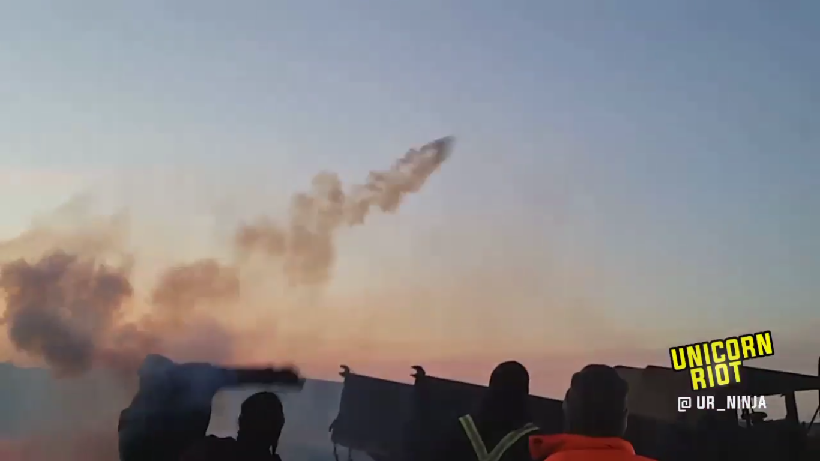
At least 300 people were injured, updated reports indicated by Wednesday, November 23rd. Around midnight of November 20th, injuries to over 160 people were reported, as medics also confirmed that a 13-year-old girl was shot in the face by law enforcement, two people suffered cardiac arrests (at least one person is in critical condition), and many contusions and damage to hands resulted from rubber bullets. Many people were also experiencing hypothermia from the water cannons and have lung and eye irritation from tear gas and mace.
We were live on and off through the night as the standoff lasted over six hours.
We are #LIVE now recapping the days events during the HWY 1806 standoff thats been ongoing for hours https://t.co/zcDC9sOoZx #NoDAPL pic.twitter.com/wGf00oIH9w
— UNICORN RIOT (@UR_Ninja) November 21, 2016
Military trucks were placed blocking Highway 1806 and have been chained to concrete barricades since the battle of October 27th, when police forces raided the Oceti Sakowin 1851 treaty camp. The police have not allowed the road to be cleared since.
Starting around 5 p.m. CST on Sunday, November 20th, water protectors attempted to pull one of the two vehicles out of the road in attempts to clear the blocked pathway. They were met by police shooting rubber bullets and tear gas at them. Some tear gas canisters were tossed immediately back to police.
5:19 PM 11/20/16: Sheriffs again fire tear gas at water protectors attempting to clear Highway 1806 bridge, canister returned. #NoDAPL pic.twitter.com/c1Tf28nkTA
— Unicorn Riot (@UR_Ninja) November 21, 2016
Rubber bullets were continually shot at those people who were attempting to push the truck out.
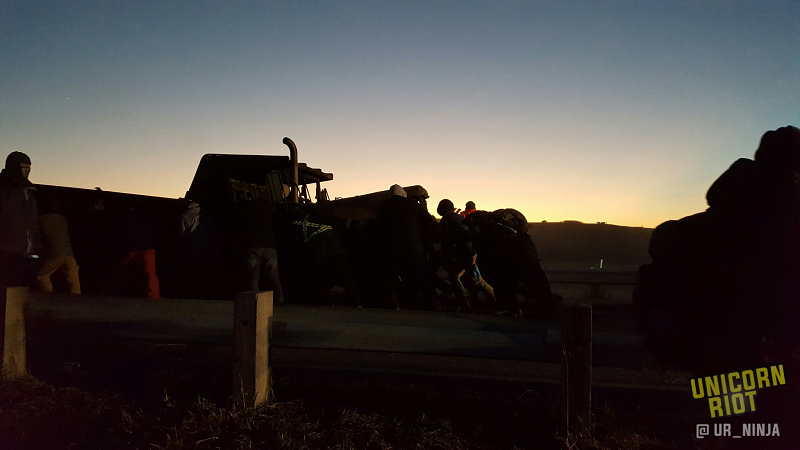
Police and military forces arrived and were seen sitting atop Bearcats and MRAP’s, pointing assault rifles and sniper rifles at unarmed water protectors from behind six feet tall razor wire.
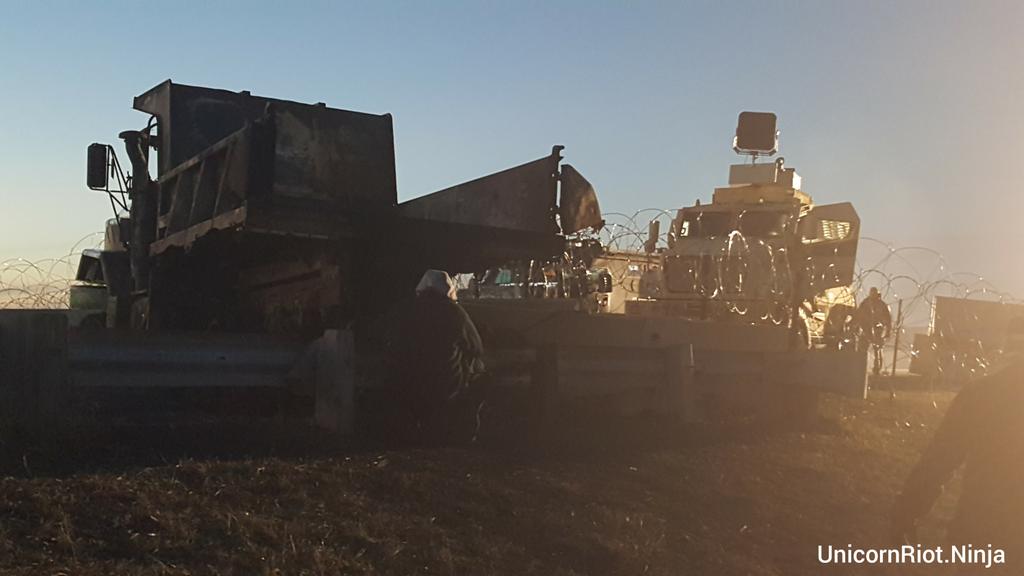
Eventually water protectors made use of a semi truck to remove one of the burnt law enforcement trucks from the highway.
11/20/16: Burnt military truck left by police to block Hwy 1806 removed by water protectors using semi & chains. #NoDAPL pic.twitter.com/2ryIRN90VV
— Unicorn Riot (@UR_Ninja) November 21, 2016
The LRAD sound cannon was used throughout the day to push back the crowd of maybe a thousand water protectors attempting to clear the Hwy 1806 blockade.
LRAD sound cannon used after water protectors throw tear gas back at North Dakota law enforcement while clearing 1806. #NoDAPL pic.twitter.com/rZYw4vcLfU
— Unicorn Riot (@UR_Ninja) November 21, 2016
A standoff that ensued for hours on the bridge happened when the gathered crowd attempted to remove the next barricaded truck.
Water protectors attempting to move 2nd vehicle from bridge to clear road for emergency vehicles to be able to come through #nodapl pic.twitter.com/MNEYdq2vSp
— UNICORN RIOT (@UR_Ninja) November 21, 2016
The police started to use a water cannon as it was activated from the top of the MRAP. It was shot directly at water protectors who were standing on the highway attempting to clear the last remaining truck.
It's 27° outside and police have begun hosing down the unarmed crowd with water cannons. Medics are rushing to frontline w/ blankets #NoDAPL
— UNICORN RIOT (@UR_Ninja) November 21, 2016
Although a Sheriff’s spokesmen stated to NBC that no water cannons were used, there remains plenty of footage of water cannons being used, as you can see below.
Sheriff’s spokesman Rob Keller told NBC that no water cannons were used and water was only deployed to put out fires set by #NoDAPL crowd. pic.twitter.com/9qc2l10rOX
— Unicorn Riot (@UR_Ninja) November 21, 2016
Despite temperatures below freezing and hovering around 24 degrees with a wind chill dipping to 15 degrees, police fired water cannons extensively at water protectors throughout the night. Morton County Sheriff Kirchmeier himself released a statement expressing concerns over the weather and its effects just two days before forces in his jurisdiction were filmed using water hoses for hours on end, before any fire was seen.
Nov 18: Morton County Sheriff expresses concern about hypothermia at #NoDAPL camps. Nov 20: uses water cannons on ppl in ~20 degree weather pic.twitter.com/1c2KaQxfUQ
— UNICORN RIOT (@UR_Ninja) November 21, 2016
Throughout the night, water protectors on the frontlines used shields to protect themselves from the barrage of water.
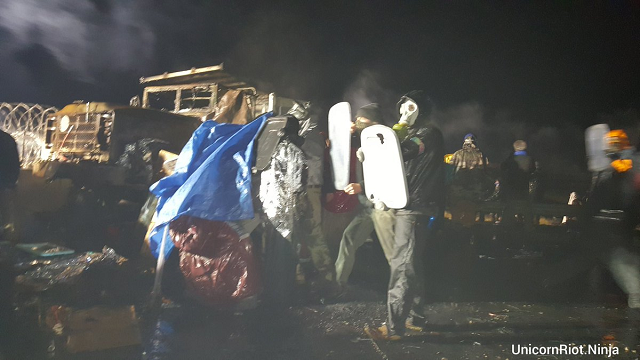
Below is a video of shielded water protectors approaching the frontline of razor wire.
8:00 PM 11/20/16: Group of water protectors with gas masks & shields advance together towards police line #NoDAPL pic.twitter.com/BSEKn1olE5
— Unicorn Riot (@UR_Ninja) November 21, 2016
Amidst the freezing water, rubber bullets, and concussion grenades, dozens among dozens of tear gas canisters were shot off by police and military forces.
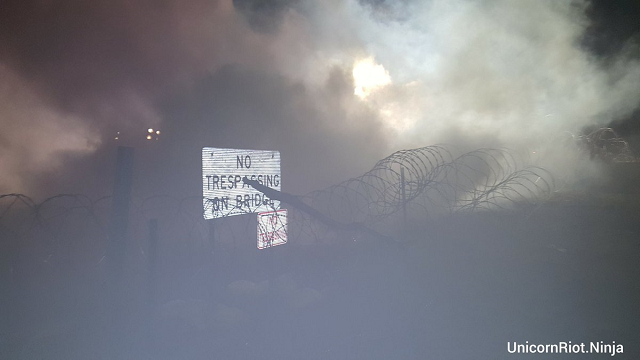
While documenting, a Unicorn Riot journalist was shot in the abdomen with a rubber bullet and their press badge was blown to pieces.
One of our reporters just had their press pass shot off when shot in the abdomen with a rubber bullet #NoDAPL pic.twitter.com/IYljH2xveL
— UNICORN RIOT (@UR_Ninja) November 21, 2016
As the actions wound down and police continued using crowd control weapons, Unicorn Riot documented the police utilizing fire trucks to put out fires that water protectors were using to get warm after being doused with water hoses.
1:30AM : a fire truck is attempting to hit fires that keep people warm , we are LIVE https://t.co/zcDC9t5ZR5 #NoDAPL pic.twitter.com/bQu1wYAtlO
— UNICORN RIOT (@UR_Ninja) November 21, 2016
1:30AM : a fire truck is attempting to hit fires that keep people warm , we are LIVE https://t.co/zcDC9t5ZR5 #NoDAPL pic.twitter.com/bQu1wYAtlO
— UNICORN RIOT (@UR_Ninja) November 21, 2016
Watch our archived livestreams from the night below:
Unicorn Riot will continue to provide direct updates about resistance to the Dakota Access Pipeline. Follow our media on Twitter, Facebook, and our website for more information surrounding the ongoing struggles against the Dakota Access Pipeline.
To support our volunteer-operated, horizontally-organized, non-profit media collective please consider a tax-deductible donation:
Unicorn Riot’s coverage of the anti-Dakota Access Pipeline struggle #NoDAPL from early summer 2016 to present:
March – May 2016
- March 29th, “Tribal Citizens Prepare to Blockade Bakken Oil Pipeline“.
- April 3rd, “Tribal Citizens Build Camp in Path of Oil Pipeline“.
- May 5th, “Sacred Stone Camp Resists Dakota Access Pipeline“.
- May 27th, “Dakota Access Pipeline Blockade Enters 2nd Month“.
August 2016
- After covering the camp in the spring of 2016, Unicorn Riot returned to Standing Rock Reservation on Wednesday, August 10th, when Standing Rock tribal members and allies blocked the entrance to the Dakota Access Pipeline construction site.
- On Thursday, August 11th, a dozen or so people were arrested blocking the construction site entrances.
- Day 3, Friday, the fight to protect land & water intensified around the construction sites of the Dakota Access Pipeline.
- On the 4th day, the pipeline resistance encampment swelled and prepared for more action.
- Monday, August 15th, land defenders stormed the construction site halting construction, and the next day construction was halted as well.
- August 17th saw State Police begin checkpoints, roadblocks, and psyops as protesters united to defend water.
- August 24th, camps prepared as Federal injunction hearing looms.
- Camps Organize to Stay as Injunction Postponed.
- On August 31st, Non-Violent Direct Action Stopped DAPL Construction for Over 6 Hours.
September 2016
- September 6, indigenous water protectors swarmed Dakota Access Pipeline site, stopped work
- September 7, Uŋpa Nuŋpa was interviewed about ongoing #noDAPL actions
- North Dakota highway patrol refused to release email correspondence with Energy Transfer Partners
- September 8, ND National Guard took over Dakota Access Pipeline checkpoints
- Friday, September 9, US Govt. overruled federal judge and requested pipeline construction halted at Lake Oahe
- Meanwhile, cultural activities continued at #NoDAPL camps despite more arrests/warrants
- September 13, 20 were arrested during #NoDAPL lockdown, including 2 Unicorn Riot journalists
- September 14, direct actions continued against Dakota Access Pipeline while legal repression intensified
- On September 16 a federal judge dissolved the unconstitutional temporary restraining order Dakota Access, LLC had filed against Stranding Rock tribal members
- September 19, as solidarity protests spread nationwide, the federal appeals court ordered construction temporarily stop on Dakota Access segment as Solidarity Protests Spread Nationwide
- September 21, #NoDAPL noise demo demanded freedom for jailed water protector Olowan Martinez
- September 22, water protectors disrupted the annual meeting of the North Dakota Petroleum Council
- September 25, water protectors planted trees on DAPL construction site
- In Iowa on September 26, a non-violent direct action from the Mississippi Stand camp stopped DAPL construction for the day
- September 26, a caravan of water protectors stopped work at DAPL site
- September 27, militarized police arrested 23 water protectors in DAPL work stoppage
- September 29, a #NoDAPL solidarity action took place at MN Enbridge office
October 2016
- October 3rd-4th saw the “Toxic Tour,” Governor debate disruption, and water protectors attend their court arraignment
- October 4, we learned North Dakota Governor Dalrymple’s email inbox was full of support for #NoDAPL
- October 5, Buffer Zone Holds as Caravans Continue to Disrupt DAPL – New Felony Charges
- October 7, 6 Arrested in Iowa #NoDAPL Action, Including Unicorn Riot Journalist
- October 8, Iowa Water Protectors Blockade DAPL Drill Site Twice in 24 Hours
- October 9, Federal Appeals Court Rules to Allow DAPL Construction
- October 10, 27 Arrests After Water Protectors Pray at DAPL Site on Indigenous People’s Day
- October 12, Lockdown Stops DAPL Construction in Iowa, 3 Arrested, Including Unicorn Riot Journalist
- October 14, Emails Show North Dakota Budget Bureaucracy Behind #NoDAPL Policing
- October 16, Direct Actions Continue to Stop DAPL Construction in Iowa and North Dakota
- October 17, Four Unicorn Riot Journalists Face Charges For Covering #NoDAPL
- October 17, Water Protectors Blockade Highway in Bismarck, Some Charges Dropped
- October 20, As DAPL Construction Advances, Water Protectors Continue Direct Action
- October 22, Water Protectors’ Prayer Walk Ends up with 127 Arrests, Including Unicorn Riot Journalist
- October 23, Law Enforcement Attack Private Drone as Water Protectors Erect Blockade & New Winter Camp
- October 24, Mississippi Stand Blockades Iowa DAPL Drill Waste Site, Drilling Stops
- October 25, Records Release: Morton County’s Law Enforcement Mutual Aid Assistance Agreement
- Hundreds Flood Minneapolis City Hall to Demand Local Sheriff Withdraw from North Dakota
- October 26, Tensions Rise as Pipeline Construction Nears #NoDAPL Blockade
- October 27, Police and Military Attack Oceti Sakowin Treaty Camp
November 2016
- November 1, #NoDAPL Solidarity Rally & Sit-In in Minneapolis Prods Sheriff into Removing Deputies
- November 1, DAPL Resistance Continues Despite Advancing Construction
- November 2, Police Attack Water Protectors Defending Sacred Sites
- November 5, DAPL Construction Nears US Army Corps Land While Still Lacking Permits
- November 6, Water Protectors Attempt to Reclaim Sacred Burial Site, Demonstrate in Cemetery
- November 8, Dakota Access Announces Plan to Drill Under Missouri River Within Weeks
- November 11, Dakota Access Pipeline Work Stopped As Water Protectors Storm Site; 30+ Arrested
- November 14, #NoDAPL Water Protectors March on ND State Capitol after Caravan Disrupts Construction
- November 14, Mississippi Stand Goes Inside Pipeline and Shuts Down DAPL Construction
- November 14, Army Corps Delays DAPL Easement
- November 15, “No More Stolen Sisters” Demonstration Blockades DAPL Man Camp; 25+ Arrests
- November 16, Despite Army Corps Statement, DAPL Moves Horizontal Drill to Missouri River Crossing
- November 17, Demonstration in Bismarck-Mandan, Cass County Deputies Beat Man Bloody


